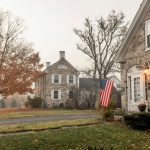A Visit to Berlin
On Wednesday I went up to Berlin, New Hampshire, to give a talk. I’ve been giving these talks for the New Hampshire Humanities Council for some time now, gigs that take me all over the state to libraries large and small as well as historical societies, some housed in big old town halls and some […]
On Wednesday I went up to Berlin, New Hampshire, to give a talk. I’ve been giving these talks for the New Hampshire Humanities Council for some time now, gigs that take me all over the state to libraries large and small as well as historical societies, some housed in big old town halls and some in historic houses. This one was in the library of a community college and to reach its doors, I had to wind through the back streets of Berlin which has not fared well in recent years. The big stacks of the shuttered paper mills rose up from behind the rows of small houses like a storm cloud, threatening. Detroit gets all the attention but the paper mill towns of northern New England have been suffering from attrition for some years. There have been no bailouts that I know of. For sale signs decorated many lawns. A man, leaning heavily on his cane, was struggling to cover the bright orange marigolds that lined his driveway, an effort to protect them from the frost that was forecast to arrive overnight. The leaves in the maples that stood sentry on these lawns had started to turn, all of which added to the feeling of sadness that filled me as I turned left, turned right, and generally bumped along the potholed streets, looking for the college. The paper industry has pretty much abandoned our north country for the bright horizons of China and it feels unlikely they will ever return. What can save communities like Berlin in times like this?
Nevertheless, a warm and cheerful group of people greeted me and we had a good evening, talking about food, which is my topic — baked beans and fried clams, how food can define a region. In it, I talk about Fannie Farmer, the pioneer of the “domestic science movement” who wrote the first cookbook to include precise measurements, and I draw the life of Julia Child, a California girl who became interested in gourmet food to please her Boston Brahmin husband, a graciousness that blossomed into a magnificent passion all her own. Her food was international and extravagant but her television career started in a little makeshift television studio in Boston, where her heart remained regardless of all the exotic places she traveled to. And Haydn S. Pearson who waxed rhapsodic over baked beans and fried corn meal mush, a man who wore his heart on his sleeve for his favorite foods. He recalls the time when everyone had cows in the barn and a garden filled with fresh produce, much of it kept through the winter in the root cellar. A simpler time, a thriftier time. I love introducing people to Haydn Pearson, who grew up in the next town to mine, the son of a minister, and who was mostly known as a nature writer before turning to his true passion: New England food. Food can always cheer us up. And it did on that evening. We laughed about Fannie’s starchy prose, the foibles of Julia and enjoyed the spirited conviction of Pearson’s writing — he maintained that if we got back to the habit of having beans on Saturday nights, the national debt would come under control. He wrote that in 1946 and I can’t say I disagree with him today. I wonder how he might have suggested we solve the healthcare crisis. I’m sure his solution would be direct, simple, practical.
After, there were refreshments and a chance to chat. Soft, spicy molasses cookies made by one of the ladies of the town fortified us. There was a warmth in the smiles of those in attendance, a happiness of sorts. New Englanders, especially northern New Englanders, are a rugged group, a breed apart. Outside, I could feel the frost starting to descend but I left with a lighter heart, knowing that things are not always as they seem from the outside.








A good, home-made meal is the best medicine for anything! I enjoyed your post today!
Only, Edie Clark can so intricately interlace (like top crust strips on an apple pie) such varied topics as Julie Child and baked beans, all in a single essay. And, have it all come out perfectly done (and read), in less time then it takes to boil an egg. Thank you Edie, as always, for sharing your wonderful words and impressions here at Yankee Magazine! ? Warmest regards, Jeff Priddy